Singapore Economy and Policy Debate: Monetary or Exchange Rate Policy?
VerifiedAdded on 2020/03/16
|12
|3025
|37
Report
AI Summary
This report provides a comprehensive analysis of the Singaporean economy, beginning with an overview of its historical development and key economic indicators, including GDP and trade. It explores the country's pro-business environment and its dependence on international trade, highlighting the impact of global events on its economic performance. The report then delves into current economic issues, such as slow growth, the impact of the global financial crisis, and shifts in trade patterns. It examines the implications of both monetary and exchange rate policies, considering their effects on price stability, economic growth, and balance of payments. The report concludes by recommending a suitable policy approach for Singapore, emphasizing the need to boost domestic consumption through monetary policy to address the challenges of slower economic growth and international trade dependencies. The analysis also includes a look at the impact of exchange rates on the economy.
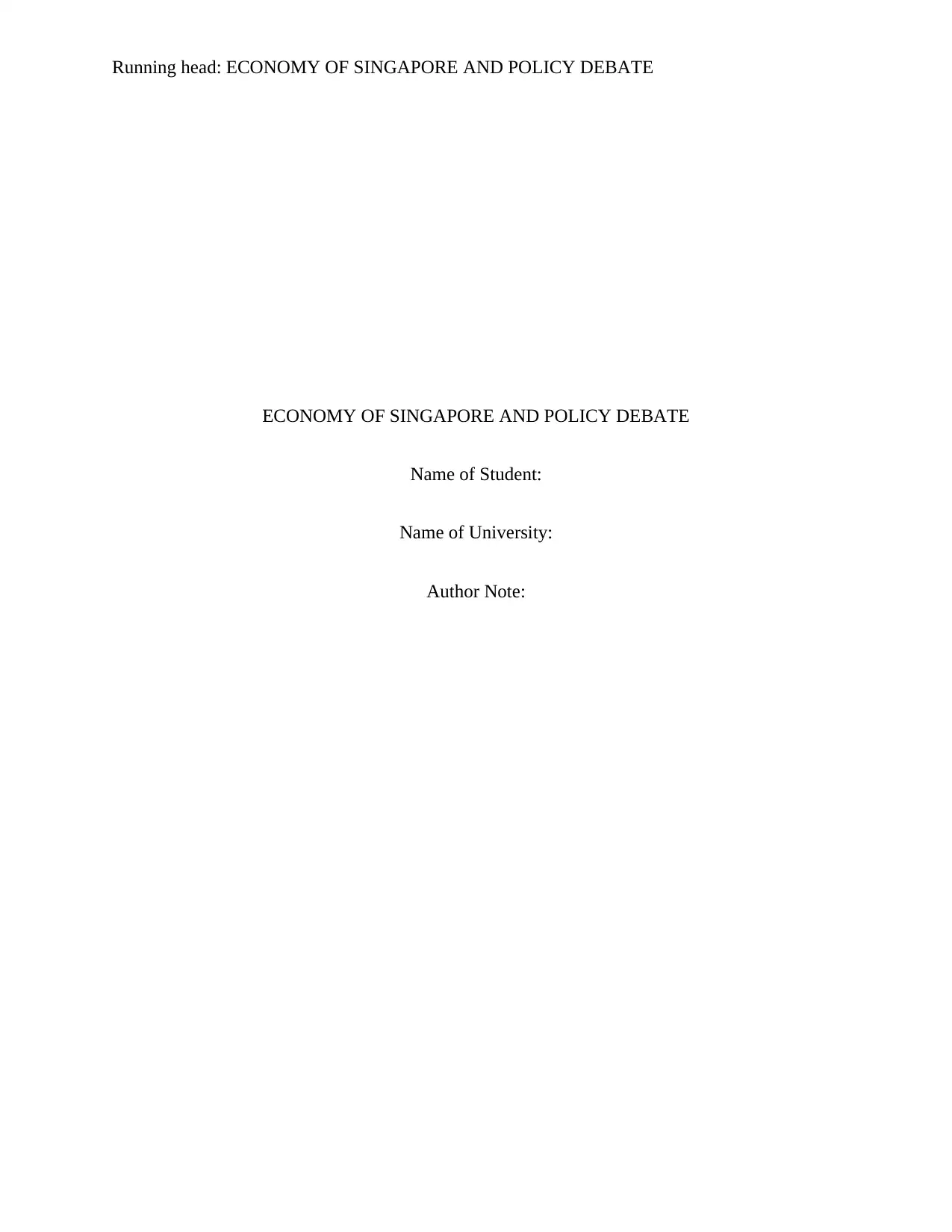
Running head: ECONOMY OF SINGAPORE AND POLICY DEBATE
ECONOMY OF SINGAPORE AND POLICY DEBATE
Name of Student:
Name of University:
Author Note:
ECONOMY OF SINGAPORE AND POLICY DEBATE
Name of Student:
Name of University:
Author Note:
Paraphrase This Document
Need a fresh take? Get an instant paraphrase of this document with our AI Paraphraser
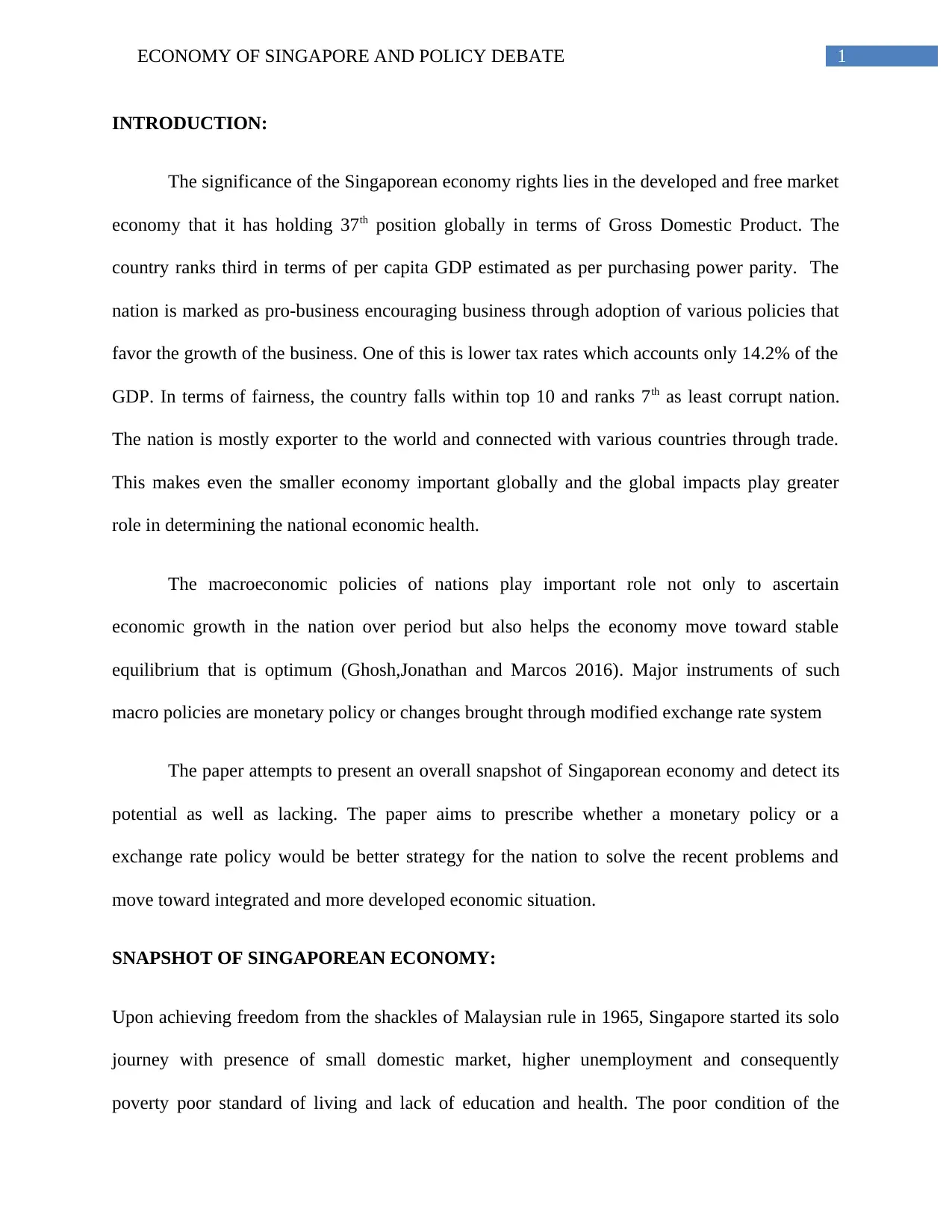
1ECONOMY OF SINGAPORE AND POLICY DEBATE
INTRODUCTION:
The significance of the Singaporean economy rights lies in the developed and free market
economy that it has holding 37th position globally in terms of Gross Domestic Product. The
country ranks third in terms of per capita GDP estimated as per purchasing power parity. The
nation is marked as pro-business encouraging business through adoption of various policies that
favor the growth of the business. One of this is lower tax rates which accounts only 14.2% of the
GDP. In terms of fairness, the country falls within top 10 and ranks 7th as least corrupt nation.
The nation is mostly exporter to the world and connected with various countries through trade.
This makes even the smaller economy important globally and the global impacts play greater
role in determining the national economic health.
The macroeconomic policies of nations play important role not only to ascertain
economic growth in the nation over period but also helps the economy move toward stable
equilibrium that is optimum (Ghosh,Jonathan and Marcos 2016). Major instruments of such
macro policies are monetary policy or changes brought through modified exchange rate system
The paper attempts to present an overall snapshot of Singaporean economy and detect its
potential as well as lacking. The paper aims to prescribe whether a monetary policy or a
exchange rate policy would be better strategy for the nation to solve the recent problems and
move toward integrated and more developed economic situation.
SNAPSHOT OF SINGAPOREAN ECONOMY:
Upon achieving freedom from the shackles of Malaysian rule in 1965, Singapore started its solo
journey with presence of small domestic market, higher unemployment and consequently
poverty poor standard of living and lack of education and health. The poor condition of the
INTRODUCTION:
The significance of the Singaporean economy rights lies in the developed and free market
economy that it has holding 37th position globally in terms of Gross Domestic Product. The
country ranks third in terms of per capita GDP estimated as per purchasing power parity. The
nation is marked as pro-business encouraging business through adoption of various policies that
favor the growth of the business. One of this is lower tax rates which accounts only 14.2% of the
GDP. In terms of fairness, the country falls within top 10 and ranks 7th as least corrupt nation.
The nation is mostly exporter to the world and connected with various countries through trade.
This makes even the smaller economy important globally and the global impacts play greater
role in determining the national economic health.
The macroeconomic policies of nations play important role not only to ascertain
economic growth in the nation over period but also helps the economy move toward stable
equilibrium that is optimum (Ghosh,Jonathan and Marcos 2016). Major instruments of such
macro policies are monetary policy or changes brought through modified exchange rate system
The paper attempts to present an overall snapshot of Singaporean economy and detect its
potential as well as lacking. The paper aims to prescribe whether a monetary policy or a
exchange rate policy would be better strategy for the nation to solve the recent problems and
move toward integrated and more developed economic situation.
SNAPSHOT OF SINGAPOREAN ECONOMY:
Upon achieving freedom from the shackles of Malaysian rule in 1965, Singapore started its solo
journey with presence of small domestic market, higher unemployment and consequently
poverty poor standard of living and lack of education and health. The poor condition of the
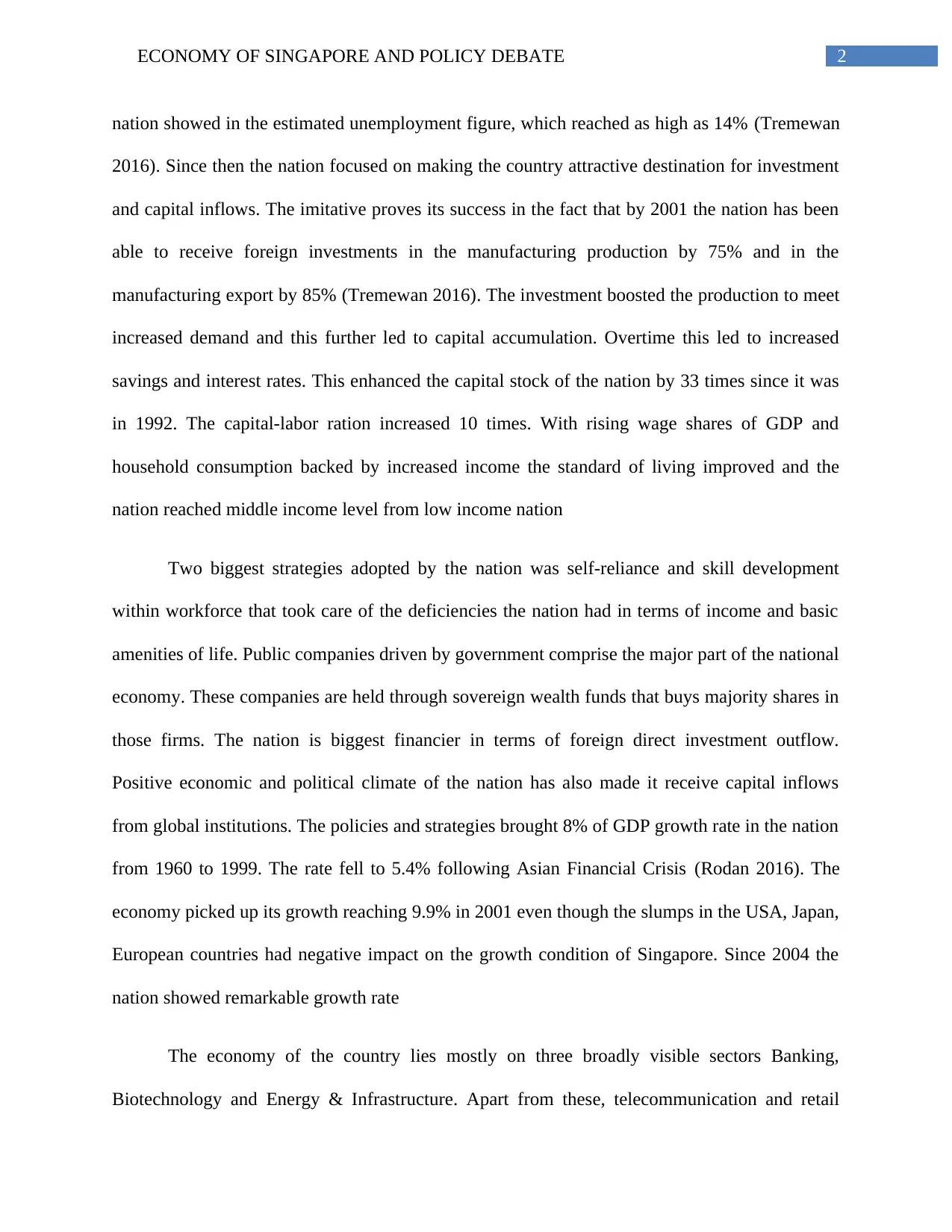
2ECONOMY OF SINGAPORE AND POLICY DEBATE
nation showed in the estimated unemployment figure, which reached as high as 14% (Tremewan
2016). Since then the nation focused on making the country attractive destination for investment
and capital inflows. The imitative proves its success in the fact that by 2001 the nation has been
able to receive foreign investments in the manufacturing production by 75% and in the
manufacturing export by 85% (Tremewan 2016). The investment boosted the production to meet
increased demand and this further led to capital accumulation. Overtime this led to increased
savings and interest rates. This enhanced the capital stock of the nation by 33 times since it was
in 1992. The capital-labor ration increased 10 times. With rising wage shares of GDP and
household consumption backed by increased income the standard of living improved and the
nation reached middle income level from low income nation
Two biggest strategies adopted by the nation was self-reliance and skill development
within workforce that took care of the deficiencies the nation had in terms of income and basic
amenities of life. Public companies driven by government comprise the major part of the national
economy. These companies are held through sovereign wealth funds that buys majority shares in
those firms. The nation is biggest financier in terms of foreign direct investment outflow.
Positive economic and political climate of the nation has also made it receive capital inflows
from global institutions. The policies and strategies brought 8% of GDP growth rate in the nation
from 1960 to 1999. The rate fell to 5.4% following Asian Financial Crisis (Rodan 2016). The
economy picked up its growth reaching 9.9% in 2001 even though the slumps in the USA, Japan,
European countries had negative impact on the growth condition of Singapore. Since 2004 the
nation showed remarkable growth rate
The economy of the country lies mostly on three broadly visible sectors Banking,
Biotechnology and Energy & Infrastructure. Apart from these, telecommunication and retail
nation showed in the estimated unemployment figure, which reached as high as 14% (Tremewan
2016). Since then the nation focused on making the country attractive destination for investment
and capital inflows. The imitative proves its success in the fact that by 2001 the nation has been
able to receive foreign investments in the manufacturing production by 75% and in the
manufacturing export by 85% (Tremewan 2016). The investment boosted the production to meet
increased demand and this further led to capital accumulation. Overtime this led to increased
savings and interest rates. This enhanced the capital stock of the nation by 33 times since it was
in 1992. The capital-labor ration increased 10 times. With rising wage shares of GDP and
household consumption backed by increased income the standard of living improved and the
nation reached middle income level from low income nation
Two biggest strategies adopted by the nation was self-reliance and skill development
within workforce that took care of the deficiencies the nation had in terms of income and basic
amenities of life. Public companies driven by government comprise the major part of the national
economy. These companies are held through sovereign wealth funds that buys majority shares in
those firms. The nation is biggest financier in terms of foreign direct investment outflow.
Positive economic and political climate of the nation has also made it receive capital inflows
from global institutions. The policies and strategies brought 8% of GDP growth rate in the nation
from 1960 to 1999. The rate fell to 5.4% following Asian Financial Crisis (Rodan 2016). The
economy picked up its growth reaching 9.9% in 2001 even though the slumps in the USA, Japan,
European countries had negative impact on the growth condition of Singapore. Since 2004 the
nation showed remarkable growth rate
The economy of the country lies mostly on three broadly visible sectors Banking,
Biotechnology and Energy & Infrastructure. Apart from these, telecommunication and retail
⊘ This is a preview!⊘
Do you want full access?
Subscribe today to unlock all pages.

Trusted by 1+ million students worldwide
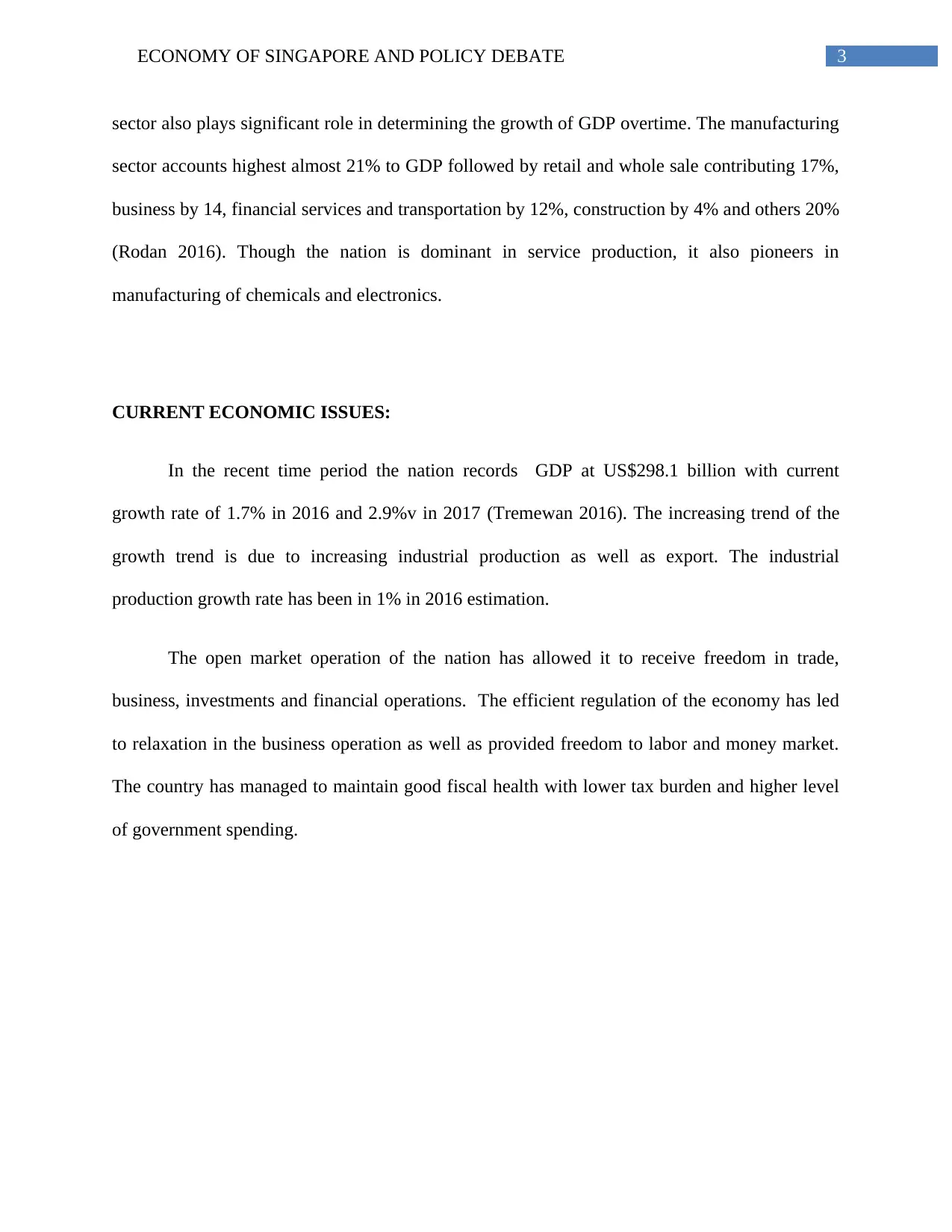
3ECONOMY OF SINGAPORE AND POLICY DEBATE
sector also plays significant role in determining the growth of GDP overtime. The manufacturing
sector accounts highest almost 21% to GDP followed by retail and whole sale contributing 17%,
business by 14, financial services and transportation by 12%, construction by 4% and others 20%
(Rodan 2016). Though the nation is dominant in service production, it also pioneers in
manufacturing of chemicals and electronics.
CURRENT ECONOMIC ISSUES:
In the recent time period the nation records GDP at US$298.1 billion with current
growth rate of 1.7% in 2016 and 2.9%v in 2017 (Tremewan 2016). The increasing trend of the
growth trend is due to increasing industrial production as well as export. The industrial
production growth rate has been in 1% in 2016 estimation.
The open market operation of the nation has allowed it to receive freedom in trade,
business, investments and financial operations. The efficient regulation of the economy has led
to relaxation in the business operation as well as provided freedom to labor and money market.
The country has managed to maintain good fiscal health with lower tax burden and higher level
of government spending.
sector also plays significant role in determining the growth of GDP overtime. The manufacturing
sector accounts highest almost 21% to GDP followed by retail and whole sale contributing 17%,
business by 14, financial services and transportation by 12%, construction by 4% and others 20%
(Rodan 2016). Though the nation is dominant in service production, it also pioneers in
manufacturing of chemicals and electronics.
CURRENT ECONOMIC ISSUES:
In the recent time period the nation records GDP at US$298.1 billion with current
growth rate of 1.7% in 2016 and 2.9%v in 2017 (Tremewan 2016). The increasing trend of the
growth trend is due to increasing industrial production as well as export. The industrial
production growth rate has been in 1% in 2016 estimation.
The open market operation of the nation has allowed it to receive freedom in trade,
business, investments and financial operations. The efficient regulation of the economy has led
to relaxation in the business operation as well as provided freedom to labor and money market.
The country has managed to maintain good fiscal health with lower tax burden and higher level
of government spending.
Paraphrase This Document
Need a fresh take? Get an instant paraphrase of this document with our AI Paraphraser
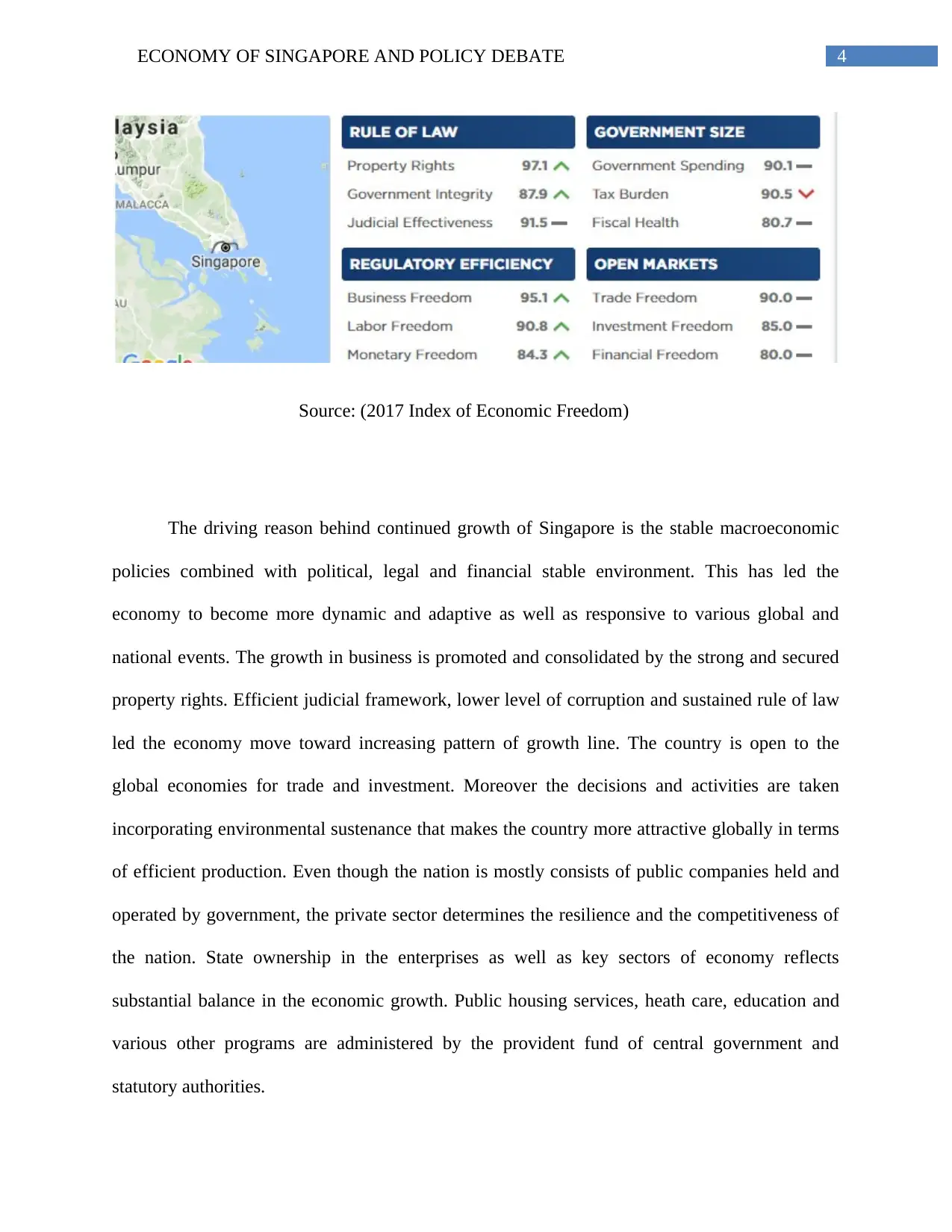
4ECONOMY OF SINGAPORE AND POLICY DEBATE
Source: (2017 Index of Economic Freedom)
The driving reason behind continued growth of Singapore is the stable macroeconomic
policies combined with political, legal and financial stable environment. This has led the
economy to become more dynamic and adaptive as well as responsive to various global and
national events. The growth in business is promoted and consolidated by the strong and secured
property rights. Efficient judicial framework, lower level of corruption and sustained rule of law
led the economy move toward increasing pattern of growth line. The country is open to the
global economies for trade and investment. Moreover the decisions and activities are taken
incorporating environmental sustenance that makes the country more attractive globally in terms
of efficient production. Even though the nation is mostly consists of public companies held and
operated by government, the private sector determines the resilience and the competitiveness of
the nation. State ownership in the enterprises as well as key sectors of economy reflects
substantial balance in the economic growth. Public housing services, heath care, education and
various other programs are administered by the provident fund of central government and
statutory authorities.
Source: (2017 Index of Economic Freedom)
The driving reason behind continued growth of Singapore is the stable macroeconomic
policies combined with political, legal and financial stable environment. This has led the
economy to become more dynamic and adaptive as well as responsive to various global and
national events. The growth in business is promoted and consolidated by the strong and secured
property rights. Efficient judicial framework, lower level of corruption and sustained rule of law
led the economy move toward increasing pattern of growth line. The country is open to the
global economies for trade and investment. Moreover the decisions and activities are taken
incorporating environmental sustenance that makes the country more attractive globally in terms
of efficient production. Even though the nation is mostly consists of public companies held and
operated by government, the private sector determines the resilience and the competitiveness of
the nation. State ownership in the enterprises as well as key sectors of economy reflects
substantial balance in the economic growth. Public housing services, heath care, education and
various other programs are administered by the provident fund of central government and
statutory authorities.
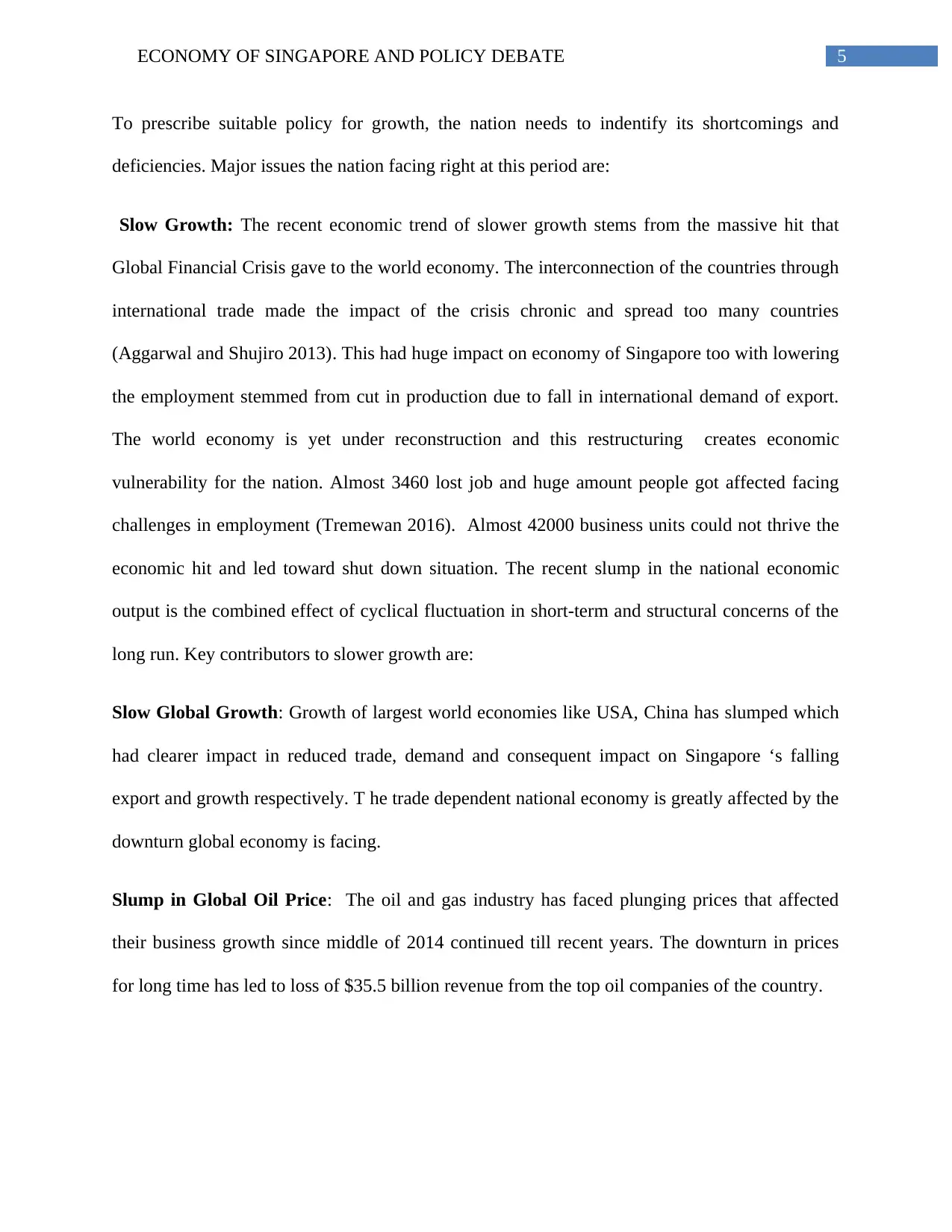
5ECONOMY OF SINGAPORE AND POLICY DEBATE
To prescribe suitable policy for growth, the nation needs to indentify its shortcomings and
deficiencies. Major issues the nation facing right at this period are:
Slow Growth: The recent economic trend of slower growth stems from the massive hit that
Global Financial Crisis gave to the world economy. The interconnection of the countries through
international trade made the impact of the crisis chronic and spread too many countries
(Aggarwal and Shujiro 2013). This had huge impact on economy of Singapore too with lowering
the employment stemmed from cut in production due to fall in international demand of export.
The world economy is yet under reconstruction and this restructuring creates economic
vulnerability for the nation. Almost 3460 lost job and huge amount people got affected facing
challenges in employment (Tremewan 2016). Almost 42000 business units could not thrive the
economic hit and led toward shut down situation. The recent slump in the national economic
output is the combined effect of cyclical fluctuation in short-term and structural concerns of the
long run. Key contributors to slower growth are:
Slow Global Growth: Growth of largest world economies like USA, China has slumped which
had clearer impact in reduced trade, demand and consequent impact on Singapore ‘s falling
export and growth respectively. T he trade dependent national economy is greatly affected by the
downturn global economy is facing.
Slump in Global Oil Price: The oil and gas industry has faced plunging prices that affected
their business growth since middle of 2014 continued till recent years. The downturn in prices
for long time has led to loss of $35.5 billion revenue from the top oil companies of the country.
To prescribe suitable policy for growth, the nation needs to indentify its shortcomings and
deficiencies. Major issues the nation facing right at this period are:
Slow Growth: The recent economic trend of slower growth stems from the massive hit that
Global Financial Crisis gave to the world economy. The interconnection of the countries through
international trade made the impact of the crisis chronic and spread too many countries
(Aggarwal and Shujiro 2013). This had huge impact on economy of Singapore too with lowering
the employment stemmed from cut in production due to fall in international demand of export.
The world economy is yet under reconstruction and this restructuring creates economic
vulnerability for the nation. Almost 3460 lost job and huge amount people got affected facing
challenges in employment (Tremewan 2016). Almost 42000 business units could not thrive the
economic hit and led toward shut down situation. The recent slump in the national economic
output is the combined effect of cyclical fluctuation in short-term and structural concerns of the
long run. Key contributors to slower growth are:
Slow Global Growth: Growth of largest world economies like USA, China has slumped which
had clearer impact in reduced trade, demand and consequent impact on Singapore ‘s falling
export and growth respectively. T he trade dependent national economy is greatly affected by the
downturn global economy is facing.
Slump in Global Oil Price: The oil and gas industry has faced plunging prices that affected
their business growth since middle of 2014 continued till recent years. The downturn in prices
for long time has led to loss of $35.5 billion revenue from the top oil companies of the country.
⊘ This is a preview!⊘
Do you want full access?
Subscribe today to unlock all pages.

Trusted by 1+ million students worldwide
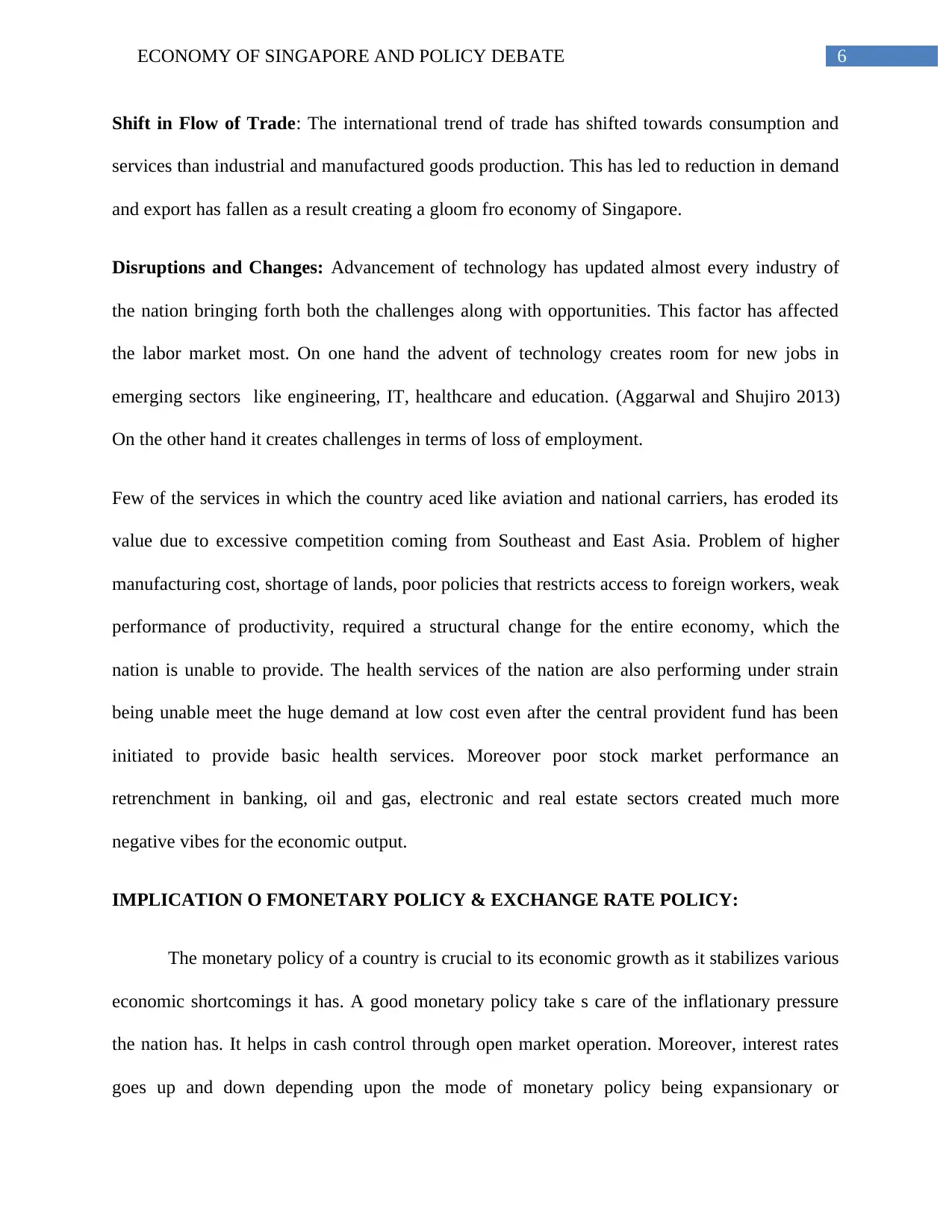
6ECONOMY OF SINGAPORE AND POLICY DEBATE
Shift in Flow of Trade: The international trend of trade has shifted towards consumption and
services than industrial and manufactured goods production. This has led to reduction in demand
and export has fallen as a result creating a gloom fro economy of Singapore.
Disruptions and Changes: Advancement of technology has updated almost every industry of
the nation bringing forth both the challenges along with opportunities. This factor has affected
the labor market most. On one hand the advent of technology creates room for new jobs in
emerging sectors like engineering, IT, healthcare and education. (Aggarwal and Shujiro 2013)
On the other hand it creates challenges in terms of loss of employment.
Few of the services in which the country aced like aviation and national carriers, has eroded its
value due to excessive competition coming from Southeast and East Asia. Problem of higher
manufacturing cost, shortage of lands, poor policies that restricts access to foreign workers, weak
performance of productivity, required a structural change for the entire economy, which the
nation is unable to provide. The health services of the nation are also performing under strain
being unable meet the huge demand at low cost even after the central provident fund has been
initiated to provide basic health services. Moreover poor stock market performance an
retrenchment in banking, oil and gas, electronic and real estate sectors created much more
negative vibes for the economic output.
IMPLICATION O FMONETARY POLICY & EXCHANGE RATE POLICY:
The monetary policy of a country is crucial to its economic growth as it stabilizes various
economic shortcomings it has. A good monetary policy take s care of the inflationary pressure
the nation has. It helps in cash control through open market operation. Moreover, interest rates
goes up and down depending upon the mode of monetary policy being expansionary or
Shift in Flow of Trade: The international trend of trade has shifted towards consumption and
services than industrial and manufactured goods production. This has led to reduction in demand
and export has fallen as a result creating a gloom fro economy of Singapore.
Disruptions and Changes: Advancement of technology has updated almost every industry of
the nation bringing forth both the challenges along with opportunities. This factor has affected
the labor market most. On one hand the advent of technology creates room for new jobs in
emerging sectors like engineering, IT, healthcare and education. (Aggarwal and Shujiro 2013)
On the other hand it creates challenges in terms of loss of employment.
Few of the services in which the country aced like aviation and national carriers, has eroded its
value due to excessive competition coming from Southeast and East Asia. Problem of higher
manufacturing cost, shortage of lands, poor policies that restricts access to foreign workers, weak
performance of productivity, required a structural change for the entire economy, which the
nation is unable to provide. The health services of the nation are also performing under strain
being unable meet the huge demand at low cost even after the central provident fund has been
initiated to provide basic health services. Moreover poor stock market performance an
retrenchment in banking, oil and gas, electronic and real estate sectors created much more
negative vibes for the economic output.
IMPLICATION O FMONETARY POLICY & EXCHANGE RATE POLICY:
The monetary policy of a country is crucial to its economic growth as it stabilizes various
economic shortcomings it has. A good monetary policy take s care of the inflationary pressure
the nation has. It helps in cash control through open market operation. Moreover, interest rates
goes up and down depending upon the mode of monetary policy being expansionary or
Paraphrase This Document
Need a fresh take? Get an instant paraphrase of this document with our AI Paraphraser
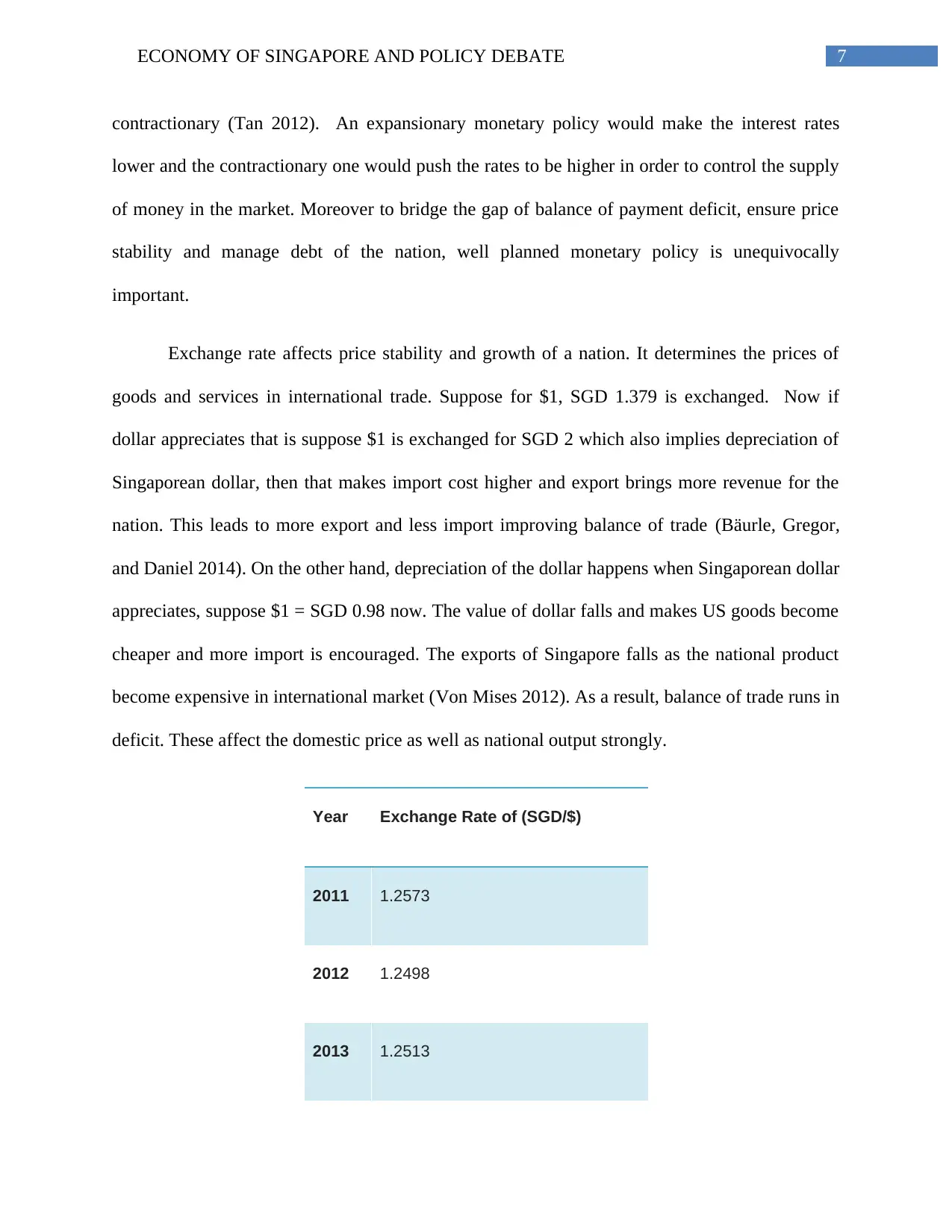
7ECONOMY OF SINGAPORE AND POLICY DEBATE
contractionary (Tan 2012). An expansionary monetary policy would make the interest rates
lower and the contractionary one would push the rates to be higher in order to control the supply
of money in the market. Moreover to bridge the gap of balance of payment deficit, ensure price
stability and manage debt of the nation, well planned monetary policy is unequivocally
important.
Exchange rate affects price stability and growth of a nation. It determines the prices of
goods and services in international trade. Suppose for $1, SGD 1.379 is exchanged. Now if
dollar appreciates that is suppose $1 is exchanged for SGD 2 which also implies depreciation of
Singaporean dollar, then that makes import cost higher and export brings more revenue for the
nation. This leads to more export and less import improving balance of trade (Bäurle, Gregor,
and Daniel 2014). On the other hand, depreciation of the dollar happens when Singaporean dollar
appreciates, suppose $1 = SGD 0.98 now. The value of dollar falls and makes US goods become
cheaper and more import is encouraged. The exports of Singapore falls as the national product
become expensive in international market (Von Mises 2012). As a result, balance of trade runs in
deficit. These affect the domestic price as well as national output strongly.
Year Exchange Rate of (SGD/$)
2011 1.2573
2012 1.2498
2013 1.2513
contractionary (Tan 2012). An expansionary monetary policy would make the interest rates
lower and the contractionary one would push the rates to be higher in order to control the supply
of money in the market. Moreover to bridge the gap of balance of payment deficit, ensure price
stability and manage debt of the nation, well planned monetary policy is unequivocally
important.
Exchange rate affects price stability and growth of a nation. It determines the prices of
goods and services in international trade. Suppose for $1, SGD 1.379 is exchanged. Now if
dollar appreciates that is suppose $1 is exchanged for SGD 2 which also implies depreciation of
Singaporean dollar, then that makes import cost higher and export brings more revenue for the
nation. This leads to more export and less import improving balance of trade (Bäurle, Gregor,
and Daniel 2014). On the other hand, depreciation of the dollar happens when Singaporean dollar
appreciates, suppose $1 = SGD 0.98 now. The value of dollar falls and makes US goods become
cheaper and more import is encouraged. The exports of Singapore falls as the national product
become expensive in international market (Von Mises 2012). As a result, balance of trade runs in
deficit. These affect the domestic price as well as national output strongly.
Year Exchange Rate of (SGD/$)
2011 1.2573
2012 1.2498
2013 1.2513
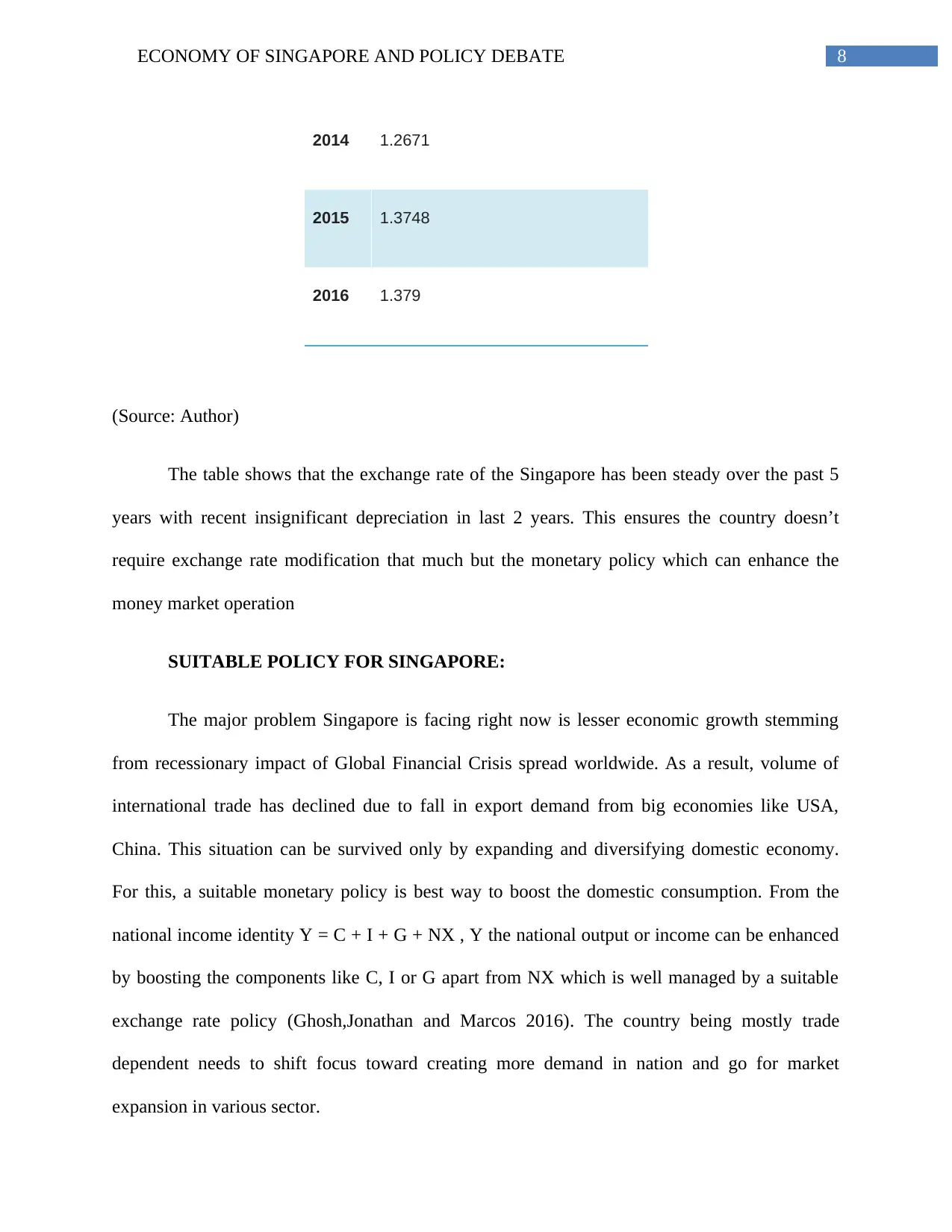
8ECONOMY OF SINGAPORE AND POLICY DEBATE
2014 1.2671
2015 1.3748
2016 1.379
(Source: Author)
The table shows that the exchange rate of the Singapore has been steady over the past 5
years with recent insignificant depreciation in last 2 years. This ensures the country doesn’t
require exchange rate modification that much but the monetary policy which can enhance the
money market operation
SUITABLE POLICY FOR SINGAPORE:
The major problem Singapore is facing right now is lesser economic growth stemming
from recessionary impact of Global Financial Crisis spread worldwide. As a result, volume of
international trade has declined due to fall in export demand from big economies like USA,
China. This situation can be survived only by expanding and diversifying domestic economy.
For this, a suitable monetary policy is best way to boost the domestic consumption. From the
national income identity Y = C + I + G + NX , Y the national output or income can be enhanced
by boosting the components like C, I or G apart from NX which is well managed by a suitable
exchange rate policy (Ghosh,Jonathan and Marcos 2016). The country being mostly trade
dependent needs to shift focus toward creating more demand in nation and go for market
expansion in various sector.
2014 1.2671
2015 1.3748
2016 1.379
(Source: Author)
The table shows that the exchange rate of the Singapore has been steady over the past 5
years with recent insignificant depreciation in last 2 years. This ensures the country doesn’t
require exchange rate modification that much but the monetary policy which can enhance the
money market operation
SUITABLE POLICY FOR SINGAPORE:
The major problem Singapore is facing right now is lesser economic growth stemming
from recessionary impact of Global Financial Crisis spread worldwide. As a result, volume of
international trade has declined due to fall in export demand from big economies like USA,
China. This situation can be survived only by expanding and diversifying domestic economy.
For this, a suitable monetary policy is best way to boost the domestic consumption. From the
national income identity Y = C + I + G + NX , Y the national output or income can be enhanced
by boosting the components like C, I or G apart from NX which is well managed by a suitable
exchange rate policy (Ghosh,Jonathan and Marcos 2016). The country being mostly trade
dependent needs to shift focus toward creating more demand in nation and go for market
expansion in various sector.
⊘ This is a preview!⊘
Do you want full access?
Subscribe today to unlock all pages.

Trusted by 1+ million students worldwide
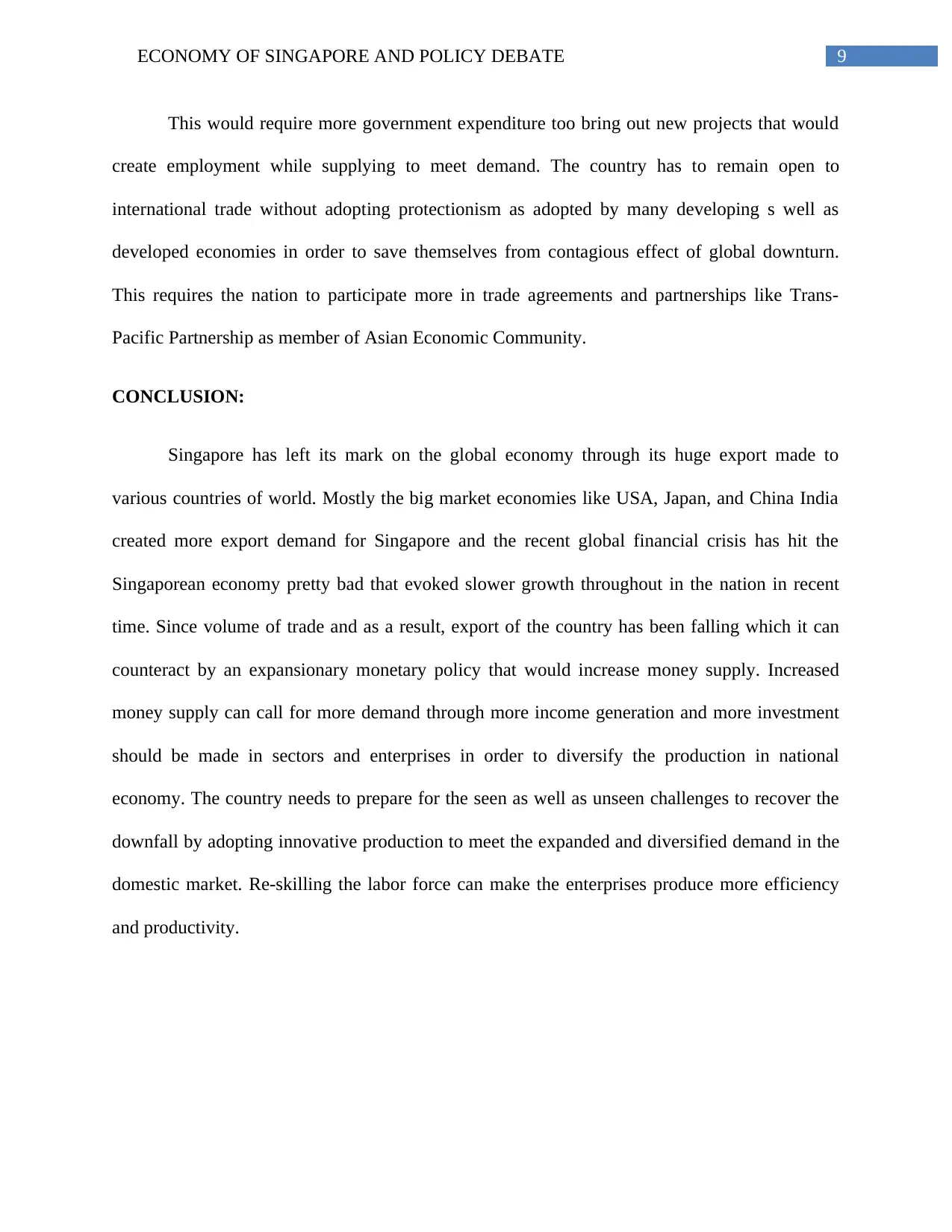
9ECONOMY OF SINGAPORE AND POLICY DEBATE
This would require more government expenditure too bring out new projects that would
create employment while supplying to meet demand. The country has to remain open to
international trade without adopting protectionism as adopted by many developing s well as
developed economies in order to save themselves from contagious effect of global downturn.
This requires the nation to participate more in trade agreements and partnerships like Trans-
Pacific Partnership as member of Asian Economic Community.
CONCLUSION:
Singapore has left its mark on the global economy through its huge export made to
various countries of world. Mostly the big market economies like USA, Japan, and China India
created more export demand for Singapore and the recent global financial crisis has hit the
Singaporean economy pretty bad that evoked slower growth throughout in the nation in recent
time. Since volume of trade and as a result, export of the country has been falling which it can
counteract by an expansionary monetary policy that would increase money supply. Increased
money supply can call for more demand through more income generation and more investment
should be made in sectors and enterprises in order to diversify the production in national
economy. The country needs to prepare for the seen as well as unseen challenges to recover the
downfall by adopting innovative production to meet the expanded and diversified demand in the
domestic market. Re-skilling the labor force can make the enterprises produce more efficiency
and productivity.
This would require more government expenditure too bring out new projects that would
create employment while supplying to meet demand. The country has to remain open to
international trade without adopting protectionism as adopted by many developing s well as
developed economies in order to save themselves from contagious effect of global downturn.
This requires the nation to participate more in trade agreements and partnerships like Trans-
Pacific Partnership as member of Asian Economic Community.
CONCLUSION:
Singapore has left its mark on the global economy through its huge export made to
various countries of world. Mostly the big market economies like USA, Japan, and China India
created more export demand for Singapore and the recent global financial crisis has hit the
Singaporean economy pretty bad that evoked slower growth throughout in the nation in recent
time. Since volume of trade and as a result, export of the country has been falling which it can
counteract by an expansionary monetary policy that would increase money supply. Increased
money supply can call for more demand through more income generation and more investment
should be made in sectors and enterprises in order to diversify the production in national
economy. The country needs to prepare for the seen as well as unseen challenges to recover the
downfall by adopting innovative production to meet the expanded and diversified demand in the
domestic market. Re-skilling the labor force can make the enterprises produce more efficiency
and productivity.
Paraphrase This Document
Need a fresh take? Get an instant paraphrase of this document with our AI Paraphraser
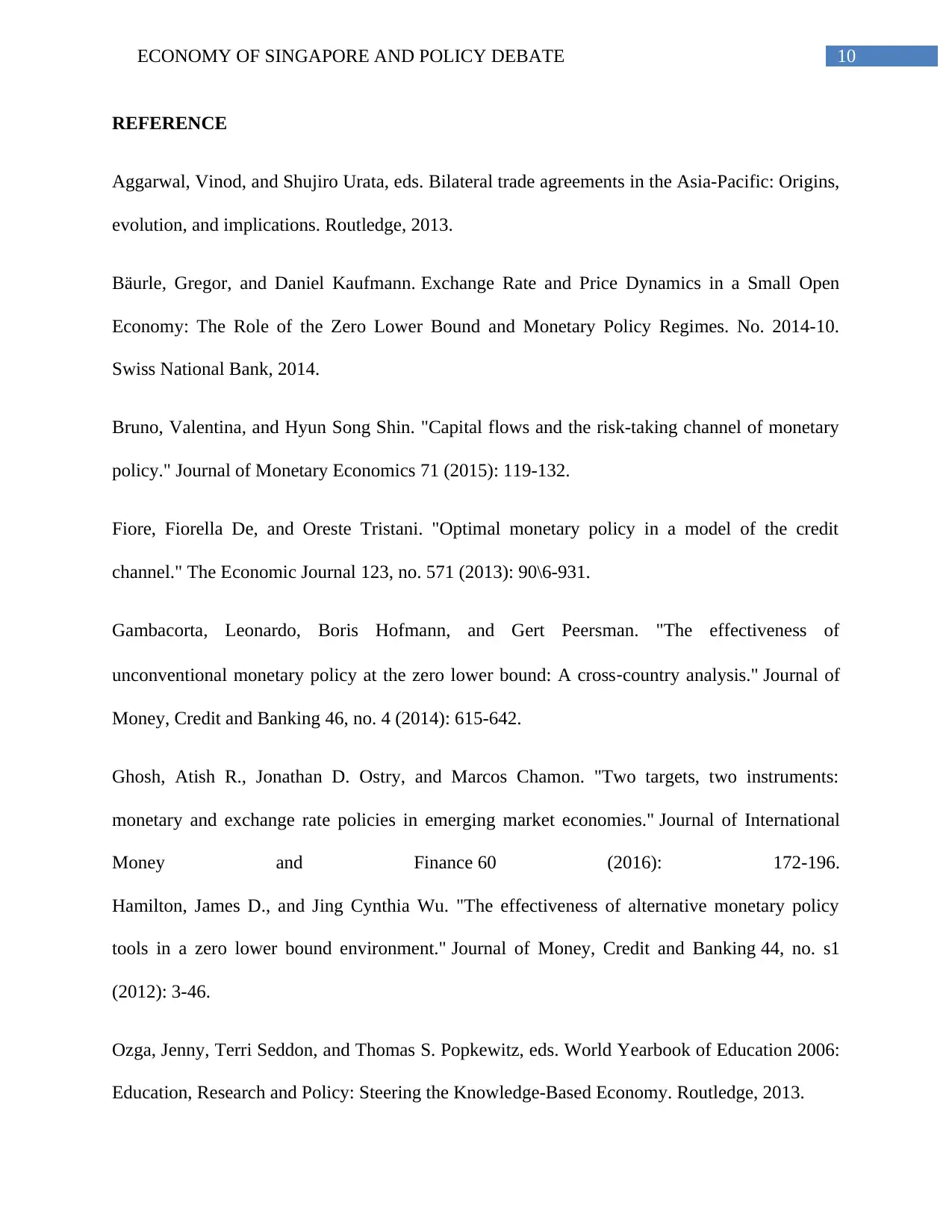
10ECONOMY OF SINGAPORE AND POLICY DEBATE
REFERENCE
Aggarwal, Vinod, and Shujiro Urata, eds. Bilateral trade agreements in the Asia-Pacific: Origins,
evolution, and implications. Routledge, 2013.
Bäurle, Gregor, and Daniel Kaufmann. Exchange Rate and Price Dynamics in a Small Open
Economy: The Role of the Zero Lower Bound and Monetary Policy Regimes. No. 2014-10.
Swiss National Bank, 2014.
Bruno, Valentina, and Hyun Song Shin. "Capital flows and the risk-taking channel of monetary
policy." Journal of Monetary Economics 71 (2015): 119-132.
Fiore, Fiorella De, and Oreste Tristani. "Optimal monetary policy in a model of the credit
channel." The Economic Journal 123, no. 571 (2013): 90\6-931.
Gambacorta, Leonardo, Boris Hofmann, and Gert Peersman. "The effectiveness of
unconventional monetary policy at the zero lower bound: A cross‐country analysis." Journal of
Money, Credit and Banking 46, no. 4 (2014): 615-642.
Ghosh, Atish R., Jonathan D. Ostry, and Marcos Chamon. "Two targets, two instruments:
monetary and exchange rate policies in emerging market economies." Journal of International
Money and Finance 60 (2016): 172-196.
Hamilton, James D., and Jing Cynthia Wu. "The effectiveness of alternative monetary policy
tools in a zero lower bound environment." Journal of Money, Credit and Banking 44, no. s1
(2012): 3-46.
Ozga, Jenny, Terri Seddon, and Thomas S. Popkewitz, eds. World Yearbook of Education 2006:
Education, Research and Policy: Steering the Knowledge-Based Economy. Routledge, 2013.
REFERENCE
Aggarwal, Vinod, and Shujiro Urata, eds. Bilateral trade agreements in the Asia-Pacific: Origins,
evolution, and implications. Routledge, 2013.
Bäurle, Gregor, and Daniel Kaufmann. Exchange Rate and Price Dynamics in a Small Open
Economy: The Role of the Zero Lower Bound and Monetary Policy Regimes. No. 2014-10.
Swiss National Bank, 2014.
Bruno, Valentina, and Hyun Song Shin. "Capital flows and the risk-taking channel of monetary
policy." Journal of Monetary Economics 71 (2015): 119-132.
Fiore, Fiorella De, and Oreste Tristani. "Optimal monetary policy in a model of the credit
channel." The Economic Journal 123, no. 571 (2013): 90\6-931.
Gambacorta, Leonardo, Boris Hofmann, and Gert Peersman. "The effectiveness of
unconventional monetary policy at the zero lower bound: A cross‐country analysis." Journal of
Money, Credit and Banking 46, no. 4 (2014): 615-642.
Ghosh, Atish R., Jonathan D. Ostry, and Marcos Chamon. "Two targets, two instruments:
monetary and exchange rate policies in emerging market economies." Journal of International
Money and Finance 60 (2016): 172-196.
Hamilton, James D., and Jing Cynthia Wu. "The effectiveness of alternative monetary policy
tools in a zero lower bound environment." Journal of Money, Credit and Banking 44, no. s1
(2012): 3-46.
Ozga, Jenny, Terri Seddon, and Thomas S. Popkewitz, eds. World Yearbook of Education 2006:
Education, Research and Policy: Steering the Knowledge-Based Economy. Routledge, 2013.
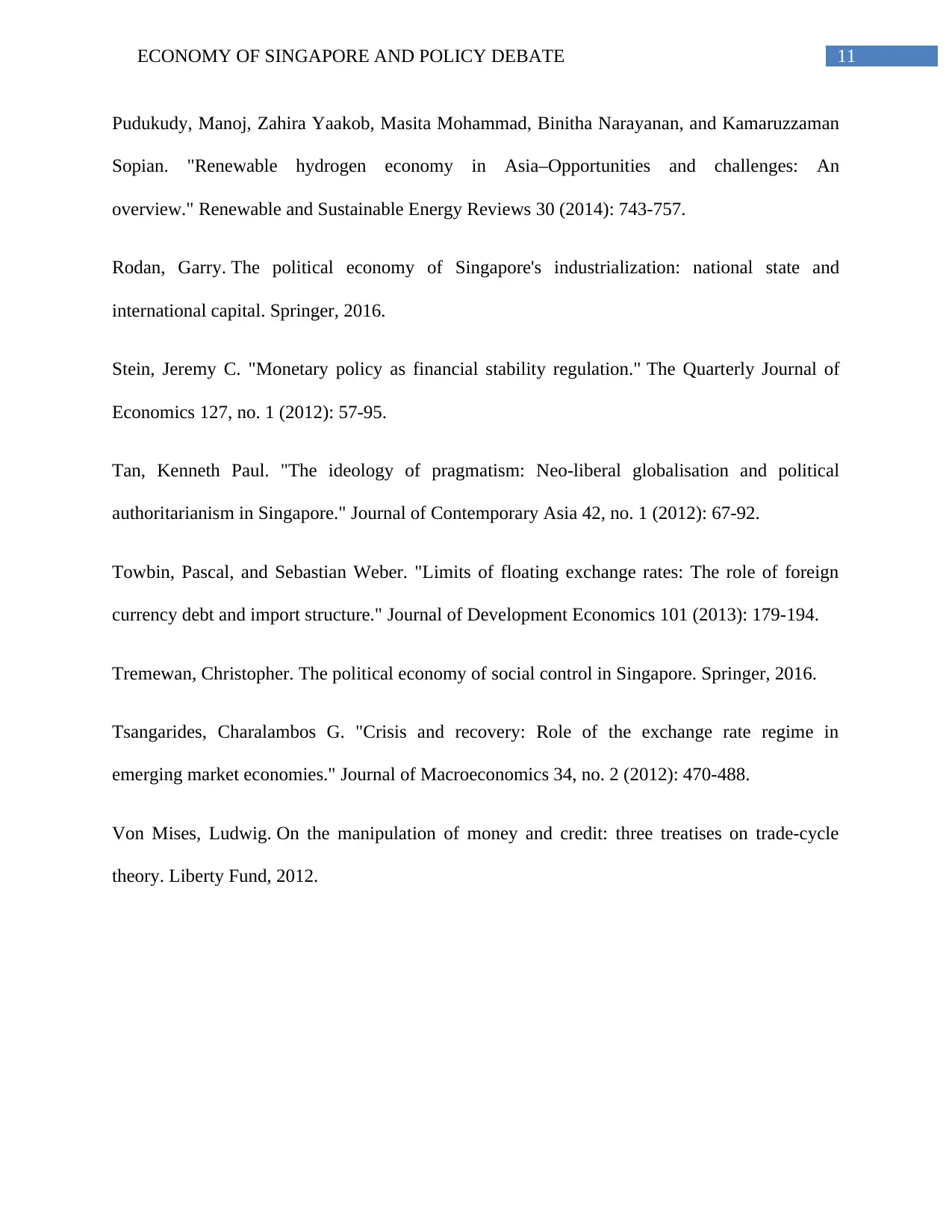
11ECONOMY OF SINGAPORE AND POLICY DEBATE
Pudukudy, Manoj, Zahira Yaakob, Masita Mohammad, Binitha Narayanan, and Kamaruzzaman
Sopian. "Renewable hydrogen economy in Asia–Opportunities and challenges: An
overview." Renewable and Sustainable Energy Reviews 30 (2014): 743-757.
Rodan, Garry. The political economy of Singapore's industrialization: national state and
international capital. Springer, 2016.
Stein, Jeremy C. "Monetary policy as financial stability regulation." The Quarterly Journal of
Economics 127, no. 1 (2012): 57-95.
Tan, Kenneth Paul. "The ideology of pragmatism: Neo-liberal globalisation and political
authoritarianism in Singapore." Journal of Contemporary Asia 42, no. 1 (2012): 67-92.
Towbin, Pascal, and Sebastian Weber. "Limits of floating exchange rates: The role of foreign
currency debt and import structure." Journal of Development Economics 101 (2013): 179-194.
Tremewan, Christopher. The political economy of social control in Singapore. Springer, 2016.
Tsangarides, Charalambos G. "Crisis and recovery: Role of the exchange rate regime in
emerging market economies." Journal of Macroeconomics 34, no. 2 (2012): 470-488.
Von Mises, Ludwig. On the manipulation of money and credit: three treatises on trade-cycle
theory. Liberty Fund, 2012.
Pudukudy, Manoj, Zahira Yaakob, Masita Mohammad, Binitha Narayanan, and Kamaruzzaman
Sopian. "Renewable hydrogen economy in Asia–Opportunities and challenges: An
overview." Renewable and Sustainable Energy Reviews 30 (2014): 743-757.
Rodan, Garry. The political economy of Singapore's industrialization: national state and
international capital. Springer, 2016.
Stein, Jeremy C. "Monetary policy as financial stability regulation." The Quarterly Journal of
Economics 127, no. 1 (2012): 57-95.
Tan, Kenneth Paul. "The ideology of pragmatism: Neo-liberal globalisation and political
authoritarianism in Singapore." Journal of Contemporary Asia 42, no. 1 (2012): 67-92.
Towbin, Pascal, and Sebastian Weber. "Limits of floating exchange rates: The role of foreign
currency debt and import structure." Journal of Development Economics 101 (2013): 179-194.
Tremewan, Christopher. The political economy of social control in Singapore. Springer, 2016.
Tsangarides, Charalambos G. "Crisis and recovery: Role of the exchange rate regime in
emerging market economies." Journal of Macroeconomics 34, no. 2 (2012): 470-488.
Von Mises, Ludwig. On the manipulation of money and credit: three treatises on trade-cycle
theory. Liberty Fund, 2012.
⊘ This is a preview!⊘
Do you want full access?
Subscribe today to unlock all pages.

Trusted by 1+ million students worldwide
1 out of 12
Related Documents
Your All-in-One AI-Powered Toolkit for Academic Success.
+13062052269
info@desklib.com
Available 24*7 on WhatsApp / Email
![[object Object]](/_next/static/media/star-bottom.7253800d.svg)
Unlock your academic potential
Copyright © 2020–2025 A2Z Services. All Rights Reserved. Developed and managed by ZUCOL.





